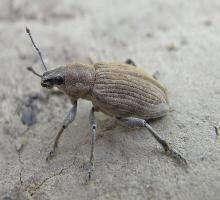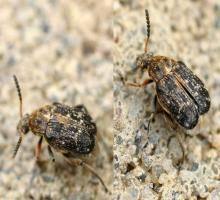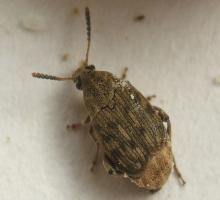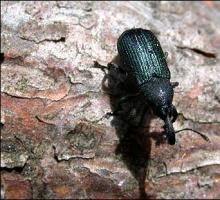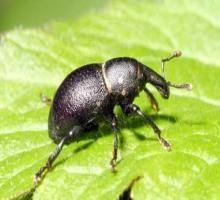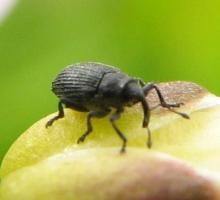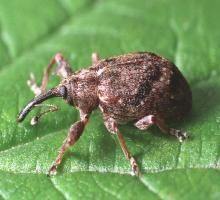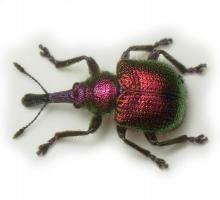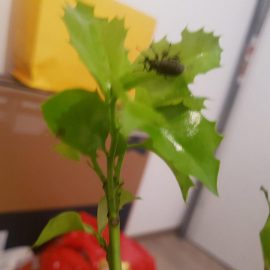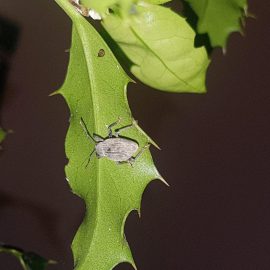Weevils – pest management
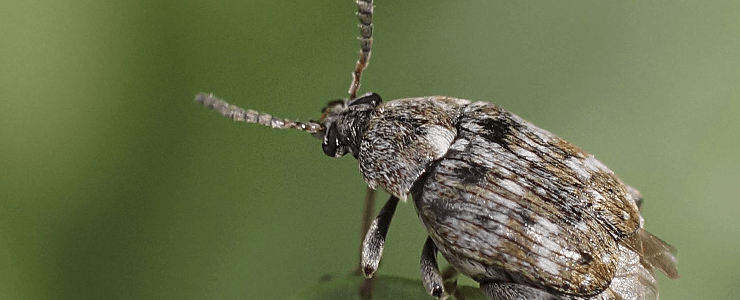
There are several species of weevils depending on the culture attacked, each with different morphology and biology.
1. The grey corn weevil – Tanymecus dilaticollis
The insect is widespread in the areas of Europe and Western Asia where corn is commonly cultivated. It was mentioned as a pest in countries such as Iran, Russia, Greece, Bulgaria. It is frequently found in the steppe and forest-steppe areas.
The adult has a gray-brown body, lighter-colored ventrally, and is 6.5-8 mm long. The adult has an elongated, oval shape, characterized by the presence of a beak called the rostrum, which is longer than the body. The egg is 0.5-1 mm long, cylindrical, rounded at the ends, white-yellow in the beginning. Later, it darkens and turns brown. The larva doesn’t have any legs, and at maturity, it reaches 8-9 mm, is bright white, and has yellow pubescence. The pupa is white, 5-9 mm long. It is considered the most destructive pest of corn, but it also feeds on other cultivated plants, producing considerable damages to cultures of sunflower, sugar beet, sorghum, soybeans, alfalfa, wheat, or barley grass. The adult cuts the area between the roots and the stem, causing the mass destruction of the culture.
Recommended products
-
You can find products on a different store
Change Store -
You can find products on a different store
Change Store -
You can find products on a different store
Change Store -
You can find products on a different store
Change Store -
You can find products on a different store
Change Store -
You can find products on a different store
Change Store -
You can find products on a different store
Change Store -
You can find products on a different store
Change Store -
You can find products on a different store
Change Store -
You can find products on a different store
Change Store -
You can find products on a different store
Change Store -
You can find products on a different store
Change Store -
You can find products on a different store
Change Store -
You can find products on a different store
Change Store -
You can find products on a different store
Change Store -
You can find products on a different store
Change Store -
You can find products on a different store
Change Store -
You can find products on a different store
Change Store -
You can find products on a different store
Change Store -
You can find products on a different store
Change Store -
You can find products on a different store
Change Store -
You can find products on a different store
Change Store -
You can find products on a different store
Change Store -
You can find products on a different store
Change Store
2. The pea weevil – Bruchus pisorum
It is a species widespread on all continents.
The adult has an elongated, oval body, black, covered with thick pubescence, gray-reddish and it is 4-5 mm long. The egg is oval, white-yellow, 1.5 mm long and 0.6 mm wide. The newborn larva is 1.5-1.6 mm long, with thin legs, a brown head, and a yellow-reddish body. The last-stage larva doesn’t have any legs, is 5-6 mm long, and is colored in white-yellow. The pupa is yellow, 4-5 mm long. It produces one generation a year and overwinters in the adult stage in warehouses, infested grains, cracks in walls and floors. The larvae gnaw the inside of the beans, forming ovoid “chambers”, consuming up to 40-50% of their mass. Adults feed on flower pollen.
3. The bean weevil – Acanthoscelides obsoletus
It is a species widespread on all continents, found especially around large cities, causing damage to stored beans. The attack in the fields is currently limited.
The adult has an elongated oval body, is 3.5-4 mm long, gray-reddish, with a black head. The egg is white, oval in shape, 0.6 mm long. The newborn larva is white. The pupa is white-yellow, 3.7-4 mm long. It can produce 2-4 generations per year, of which one in the field and the rest in warehouses. It overwinters as an adult exclusively in warehouses, in beans, or cracks in walls, ceilings, and floors. The larvae are the ones that produce most of the damage, by feeding on the beans. Depending on the size of the beans, 1-28 larvae can develop inside.
4. The cabbage weevils – Baris chlorizans
It is a species widespread throughout Europe. The adult has an elongated body, 3.5-6 mm long, blue-green, with metallic gloss on its back. The egg is oval, white, and the larva has a curved body, 5-6 mm long, white, and with a brown head.
A species that produces only one generation per year and overwinters as an adult, at a depth of 5-10 cm in the soil, under the plant debris, left behind after the harvest, or in the cabbage stocks. The insect attacks cruciferous plants in general, the most significant damage being recorded in the seed crops of cabbage, cauliflower, kohlrabi, radishes, etc. Adults bite the leaves, and the larvae gnaw on the petiole and stems. Chemical control measures consist in applying a preventive treatment to the seedlings, 1-2 days before planting, followed by a second treatment, 8-10 days after planting.
Recommended products
-
You can find products on a different store
Change Store -
You can find products on a different store
Change Store -
You can find products on a different store
Change Store -
You can find products on a different store
Change Store -
You can find products on a different store
Change Store -
You can find products on a different store
Change Store -
You can find products on a different store
Change Store -
You can find products on a different store
Change Store -
You can find products on a different store
Change Store -
You can find products on a different store
Change Store -
You can find products on a different store
Change Store -
You can find products on a different store
Change Store -
You can find products on a different store
Change Store -
You can find products on a different store
Change Store -
You can find products on a different store
Change Store -
You can find products on a different store
Change Store -
You can find products on a different store
Change Store -
You can find products on a different store
Change Store -
You can find products on a different store
Change Store -
You can find products on a different store
Change Store -
You can find products on a different store
Change Store -
You can find products on a different store
Change Store -
You can find products on a different store
Change Store -
You can find products on a different store
Change Store
5. The carrot weevils – Liparus coronatus
The adult has a black body with light brown elytra and fine dots. The length of the body is 12-15 mm. The larva doesn’t have any legs, it has a curved, white body, while the head is well developed and black. It produces one generation per year, overwintering in the mature larval stage in the soil at a depth of 15-20 cm. They pupate in spring. The larvae penetrate the carrot roots, digging galleries that reach the area between the roots and the stem. Adults attack both the roots and the leaves, producing “galleries” in the tissues.
6. The onion weevils – Ceutorhynchus suturalis
A species is widespread in some European countries. The adult has a black-gray body, 2-3 mm long. The egg is oval, translucent. The larva is yellow, with a reddish-brown head, 6-7 mm long. The pupa is 2.5-3.5 mm long, yellow.
It produces one generation per year and overwinters as an adult in the plant debris left on the ground after harvest, under lumps of soil, or in the soil at a depth of 3 cm. In spring, at the end of March, adults appear. They feed on the parenchyma of onion leaves. The hatched larvae penetrate the onion leaves, feeding on the young tissues, leaving the epidermis intact. As prevention and control measures, deep autumn plowing is recommended to destroy the hibernating adults, along with treatments with insecticides.
Recommended products
-
You can find products on a different store
Change Store -
You can find products on a different store
Change Store -
You can find products on a different store
Change Store -
You can find products on a different store
Change Store -
You can find products on a different store
Change Store -
You can find products on a different store
Change Store -
You can find products on a different store
Change Store -
You can find products on a different store
Change Store -
You can find products on a different store
Change Store -
You can find products on a different store
Change Store -
You can find products on a different store
Change Store -
You can find products on a different store
Change Store -
You can find products on a different store
Change Store -
You can find products on a different store
Change Store -
You can find products on a different store
Change Store -
You can find products on a different store
Change Store -
You can find products on a different store
Change Store -
You can find products on a different store
Change Store -
You can find products on a different store
Change Store -
You can find products on a different store
Change Store -
You can find products on a different store
Change Store -
You can find products on a different store
Change Store -
You can find products on a different store
Change Store -
You can find products on a different store
Change Store
7. The apple blossom weevils – Anthonomus pomorum
The insect is widespread in Europe and North Africa, being found in orchards in hilly and sub-mountainous areas. The adult has a reddish-brown body, 5-6 mm long, with a blackhead. The larva is a Curculionidae, 7-8 mm long, white-yellow.
It produces one generation per year and overwinters in the adult stage, in cracks in the bark of the trunk and thick branches, or under the carpet of leaves at the base of the tree trunk. The insect has a monophagous diet, the weevils gnaw the flower buds and the apple blossoms. The larvae feed on the internal organs of the apple flower buds, less often infesting pear and quince trees. In a flower bud, a single larva develops. The attacked flower buds become rubiginous, then dry out, do not open, and fall. Chemical treatments with specific insecticides are recommended (when there is a warning about a possible infestation).
Recommended products
-
You can find products on a different store
Change Store -
You can find products on a different store
Change Store -
You can find products on a different store
Change Store -
You can find products on a different store
Change Store -
You can find products on a different store
Change Store -
You can find products on a different store
Change Store -
You can find products on a different store
Change Store -
You can find products on a different store
Change Store -
You can find products on a different store
Change Store -
You can find products on a different store
Change Store -
You can find products on a different store
Change Store -
You can find products on a different store
Change Store -
You can find products on a different store
Change Store -
You can find products on a different store
Change Store -
You can find products on a different store
Change Store -
You can find products on a different store
Change Store -
You can find products on a different store
Change Store -
You can find products on a different store
Change Store -
You can find products on a different store
Change Store -
You can find products on a different store
Change Store -
You can find products on a different store
Change Store -
You can find products on a different store
Change Store -
You can find products on a different store
Change Store -
You can find products on a different store
Change Store
8. The fruit weevils – Rhynchites bacchus
A species found throughout the Palearctic region. It is spread especially in the steppe and forest-steppe regions, infesting apple, apricot, and plum orchards.
The adult has a green body with a copper or purple gloss, covered with dark brown hairs. The ventral side is white. The larva has a white-yellow body, covered with sparse hairs, and it is 4.5-6.5 mm long. The pupa is white, covered with hairs, and is 7-7.5 mm long. The egg is ellipsoidal, yellowish-white, 1 mm long. It produces a generation per year or one every 2 years and it overwinters in the adult stage, under the exfoliating bark of trees, under fallen leaves, or in the surface layer of the soil. When it produces a generation at 2 years, it overwinters one year in the larva stage in the soil or mummified fruits still attached to the trees, and in the second year in the adult stage. Hibernating adults feed on leaf and flower buds, freshly formed leaves, and fruits of apricot, peach, plum, apple, cherry trees, etc. The larvae grow in the fruits, feeding on the mesocarp and raw seeds.
As control measures, it is recommended to remove and destroy the mummified fruits left in the trees or fallen under the crown of the trees, to use traps for catching hibernating adult weevils, and to apply chemical treatments for adults with specific insecticides.
Recommended products
-
You can find products on a different store
Change Store -
You can find products on a different store
Change Store -
You can find products on a different store
Change Store -
You can find products on a different store
Change Store -
You can find products on a different store
Change Store -
You can find products on a different store
Change Store -
You can find products on a different store
Change Store -
You can find products on a different store
Change Store -
You can find products on a different store
Change Store -
You can find products on a different store
Change Store -
You can find products on a different store
Change Store -
You can find products on a different store
Change Store -
You can find products on a different store
Change Store -
You can find products on a different store
Change Store -
You can find products on a different store
Change Store -
You can find products on a different store
Change Store -
You can find products on a different store
Change Store -
You can find products on a different store
Change Store -
You can find products on a different store
Change Store -
You can find products on a different store
Change Store -
You can find products on a different store
Change Store -
You can find products on a different store
Change Store -
You can find products on a different store
Change Store -
You can find products on a different store
Change Store














































































































































































































































































































































































































































